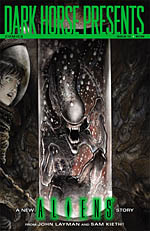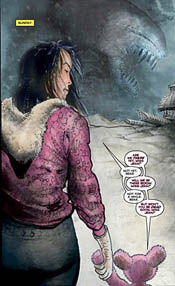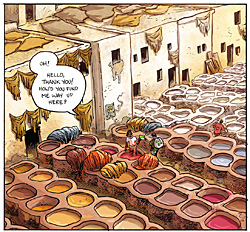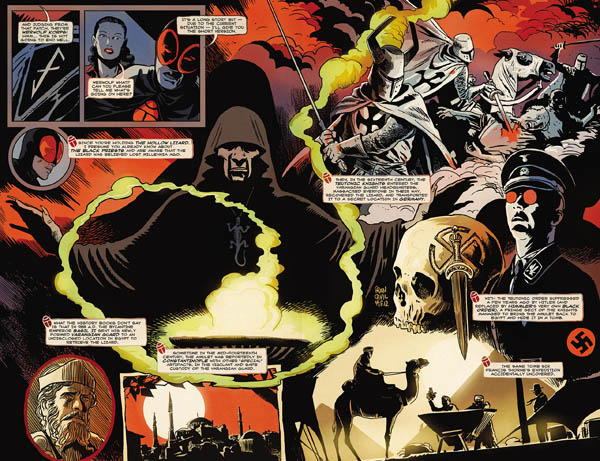 Written by John Layman, John Arcudi, Carla Speed McNeil, Steve Niles, Evan Dorkin, Tim Seeley, Francesco Francavilla, Dean Motter, Mike Baron, Harlan Ellison, and Mike Russell
Written by John Layman, John Arcudi, Carla Speed McNeil, Steve Niles, Evan Dorkin, Tim Seeley, Francesco Francavilla, Dean Motter, Mike Baron, Harlan Ellison, and Mike Russell
Art by Sam Kieth, Jonathan Case, Carla Speed McNeil, Christopher Mitten, Evan Dorkin, Victor Drujiniu, Francesco Francavilla, Dean Motter, Steve Rude, Richard Corben, and Mike Russell
80 pages, color
Published by Dark Horse
Dark Horse Presents is a title that I perpetually feel should be a blockbuster seller in today’s comics industry. It offers up so much of what readers say they want; an anthology of different types of stories, with a mixture of old and new creators bringing their A-game to the page. With this latest issue, I think it’s as good a sign as any on how well the series has settled into its format, and finding just the right material for everyone to enjoy something.
 The new issue opens with an Aliens story by John Layman and Sam Kieth. It’s hard to not find myself flashing back to the early ’90s when Keith drew the third Aliens mini-series for Mark Verheiden (originally titled Aliens: Earth War, since renamed Aliens: Female War) and the comic property was one of the hottest things on the market. It’s good timing for the return of the nasty creatures, with the quasi-prequel Prometheus on the horizon. Layman is just getting things rolling here; a cold opening with our protagonist in a bad situation, then shifting to a quieter time where we learn that Ms. Dupaul is more than initially meets the eye. It’s not a bad beginning but it is a little slow, and makes me wish for a boost on the normal 8-page allocation for a first chapter. Kieth’s art looks good, though; his rendition of the aliens are creepy as their jaws unhinge in an unnatural way, and you can tell Kieth’s having fun with all of those teeth.
The new issue opens with an Aliens story by John Layman and Sam Kieth. It’s hard to not find myself flashing back to the early ’90s when Keith drew the third Aliens mini-series for Mark Verheiden (originally titled Aliens: Earth War, since renamed Aliens: Female War) and the comic property was one of the hottest things on the market. It’s good timing for the return of the nasty creatures, with the quasi-prequel Prometheus on the horizon. Layman is just getting things rolling here; a cold opening with our protagonist in a bad situation, then shifting to a quieter time where we learn that Ms. Dupaul is more than initially meets the eye. It’s not a bad beginning but it is a little slow, and makes me wish for a boost on the normal 8-page allocation for a first chapter. Kieth’s art looks good, though; his rendition of the aliens are creepy as their jaws unhinge in an unnatural way, and you can tell Kieth’s having fun with all of those teeth.
Two other long-running properties also debut this month. Dean Motter brings Mister X to Dark Horse Presents starting this month, and while it’s a character I know primarily through reputation (I’ve read one or two stories over the years, but not much or often), I felt that Motter draws new readers in quickly, here. It helps that Mister X here is primarily a detective story, and his iconic, slightly angular art style looks fantastic. This is a comic that I’d cheerfully read just for the visuals, but the plot works well enough (despite a little bit of heavy exposition in places) that it’s a good package all around. Mike Baron and Steve Rude’s Nexus, on the other hand, feels like it’s lacking a bit of energy. I read a lot of the Nexus comics and collections from Dark Horse back in the day, but this is a little slower than I remember. The idea of a new moon appearing over Ylum and driving people crazy is interesting, and the start of Nexus being on said moon works well. But there’s no real introduction to the character given, and the art seems a little uncharacteristically sloppy in places. I’d expected much better for Nexus‘s return to Dark Horse.
Also a returning property from an earlier time is John Arcudi’s The Creep, with Jonathan Case drawing this latest story. What I found myself enjoying about this story was not only the plot itself (as Oxel begins to investigate a teenage death), but how even though it’s a part 2, I feel that you could jump in here and still enjoy it. Arcudi’s been in the industry long enough to understand how to tell a serialized story so you can step in at a later point and not be lost, and as an added bonus his writing is as strong and inviting as ever. Case is a good pair for Arcudi here, too; he’s able to draw Oxel’s misshapen features well, and his understanding of how to pace a story panel by panel across the page is good.
 Meanwhile, Carla Speed McNeil’s Finder: Third World is all the way on its tenth chapter, but I’m impressed that because of the recent shift in scenery, it’s another story that you could jump in on and get the basic gist of what’s happening. This chapter in particular has a lot of what has always attracted me to McNeil’s Finder series; it digs into the make-up of the world in general, giving us a social primer as Jaeger discovers just what the "third world" that he’s landed in really is, and how (if at all) he fits into its set-up. It ends up being a fascinating discussion, and it makes the world of Finder that much richer, even as it also helps establish just how far away from Anvard Jaeger’s landed. I’m also loving seeing Finder in full-color; McNeil’s ragged main character of Jaeger looks great as always, but the different cultures and slices of humanity are all bursting to life here, and seeing little details like the groupings of dying vats each being a different color, or the way the smoke fades into the background as the scholar puffs on his cigarette looks fantastic.
Meanwhile, Carla Speed McNeil’s Finder: Third World is all the way on its tenth chapter, but I’m impressed that because of the recent shift in scenery, it’s another story that you could jump in on and get the basic gist of what’s happening. This chapter in particular has a lot of what has always attracted me to McNeil’s Finder series; it digs into the make-up of the world in general, giving us a social primer as Jaeger discovers just what the "third world" that he’s landed in really is, and how (if at all) he fits into its set-up. It ends up being a fascinating discussion, and it makes the world of Finder that much richer, even as it also helps establish just how far away from Anvard Jaeger’s landed. I’m also loving seeing Finder in full-color; McNeil’s ragged main character of Jaeger looks great as always, but the different cultures and slices of humanity are all bursting to life here, and seeing little details like the groupings of dying vats each being a different color, or the way the smoke fades into the background as the scholar puffs on his cigarette looks fantastic.
Tim Seeley and Victor Drujiniu’s second chapter of The Occultist is much stronger than the first; I feel like it’s got a more active plot now, and any story that uses the phrase "it’s like High School Musical from Hell in there" is already heading down the right direction. Drujiniu’s art was the stronger part of the collaboration last time, and here it’s just as good; I like the flow and general form of his art to begin with, but the panels where we see the old-era drawings of demons while the Occultist flips through the books are an especially nice touch, giving a visual change-up.
There aren’t any bad stories in Dark Horse Presents #12 (a difficult feat for any 80-page anthology!), but a few stories don’t quite click. Criminal Macabre by Steve Niles and Christopher Mitten is failing to grab me, despite having enjoyed a lot of work from both creators in the past. The story just feels a little plodding, and Mitten’s art in color doesn’t have the same texture and depth that I’ve enjoyed on books like Wasteland. Evan Dorkin serves up another helping from House of Fun; most this time is taken up by The Eltingville Club, his group of hardcore geeks that are ostensibly friends but spend most of their time bickering with one another. This installment has them going to a zombie march; if you’re into zombies their discussion/argument about different types of zombies will be a riot, but for those of us who are burnt out on the genre, it’s missing the zip normally present from the Eltingville geeks. It does close out with a one-page Milk & Cheese strip, though, and who knew that the two taking off their gloves could be so creepy?

Francesco Francavilla’s The Black Beetle is probably the most frustrating of the three stories that don’t quite come together, because I feel that it’s so close. Francavilla’s plotting is fine, and the art is unsurprisingly drop-dead gorgeous. His two pages of the history of the Hollow Lizard amulet are amazing, with elements bleeding into one another, and reminding me of artists like Timothy Truman with his thick, textured ink line that works so well with the color palette. I just wish that Francavilla worked with another writer on the script; it’s better than the first issue, but it still sounds a little stilted in places, very dry and with some uneven exposition. The fact that it has improved here gives me a lot of hope that we’ll see it get a little better still in the concluding chapter, but a slight helping hand could have knocked this story to the top of the chart for this issue.
The issue closes with a prose piece and two short one-pagers. First is a reprint of Harlan Ellison’s short story "Sensible City," with two spot illustrations by Richard Corben. It’s a story that’s just as entertaining as I remember reading it almost 20 years ago, and while I’m a little puzzled on why it’s here, it’s enough fun (playing on the notion of what happens in movies and how smart people don’t do those sorts of things) that I don’t mind it. The two illustrations by Corben don’t add anything to the story, though, and in some ways feel like more of an after-thought. Mike Russell takes the final two pages with two Sabretooth Vampire stories. They’re little trifles and not memorable, but they are awfully funny. I laughed thanks to both the overall look as well as what happens to the pathetic little vampire, and it’s a good a note as any to end the issue with.
Dark Horse Presents #12 is, unsurprisingly, another good issue. With shelf space a premium these days, it takes a certain level of quality to end up staying here instead of either being given to a friend or donated to the library. I’ve now got twelve issues of Dark Horse Presents lined up nicely on the shelf next to my computer, and I look forward to watching that row of issues grow and grow. If you aren’t reading this anthology series, we’re at as good a place as any to give it a whirl.
